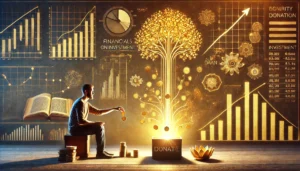
Charity and Prosperity
Charity and Wealth Management: The Concept of Daan (Donation) and Its Financial Benefits in Modern Life
Introduction
Charity, or daan, has been a cornerstone of Indian philosophy and spiritual practice for millennia. Rooted in the teachings of Sanatan Dharma, it signifies the act of selfless giving without expecting anything in return. However, in today’s world, charity is not just a moral obligation or spiritual endeavor but also a strategic component of financial planning and wealth management. This article explores the concept of daan, its historical and cultural significance, and how modern individuals can integrate it into their financial lives to reap both spiritual and financial benefits.
The Spiritual Roots of Daan in Sanatan Dharma
In ancient Indian scriptures, daan is revered as a sacred act. It is often categorized into various types based on its intent and recipient:
Annadaan (Donation of Food): Providing nourishment to the hungry is considered the highest form of charity.
Vidyadaan (Donation of Knowledge): Sharing education and wisdom is deemed essential for societal progress.
Goudaan (Donation of Cows): An ancient practice signifying agricultural and economic prosperity.
Bhoomidaan (Donation of Land): Offering land for temples, schools, or the needy reflects ultimate selflessness.
The Bhagavad Gita emphasizes that charity should be given with purity, humility, and without expectation. Similarly, the Manusmriti and Mahabharata reiterate the idea of sharing wealth as a duty to society.
Table of Contents
The Intersection of Daan and Modern Wealth Management
While the spiritual aspect of daan focuses on selflessness, its integration into modern wealth management reveals practical benefits:
- Tax Benefits and Financial Incentives
In many countries, including India, charitable donations qualify for tax deductions. Under Section 80G of the Income Tax Act, contributions to registered charitable organizations reduce taxable income, allowing individuals to save on taxes while contributing to society.
- Legacy Building
Philanthropy plays a crucial role in legacy building. By establishing charitable trusts or endowments, individuals can ensure their wealth serves meaningful purposes even after their lifetime. This practice aligns with the ancient principle of leaving behind a better world.
- Portfolio Diversification Through Social Investments
Modern wealth management often includes social investments, such as funding sustainable development projects or social enterprises. These investments not only provide financial returns but also create positive societal impact, resonating with the principles of daan.
- Emotional and Psychological Benefits
Research shows that acts of giving improve mental well-being. Charity fosters gratitude, reduces stress, and cultivates a sense of purpose, which indirectly influences financial decision-making by promoting clarity and confidence.

Charity and Prosperity
Daan in the Context of Corporate Social Responsibility (CSR)
The philosophy of daan extends beyond individuals to corporations. The Indian Companies Act, 2013, mandates that companies meeting certain criteria allocate at least 2% of their net profit to CSR activities. This regulation embodies the essence of daan, encouraging organizations to give back to the community.
Key Areas of Corporate Giving:
Education and skill development
Environmental sustainability
Healthcare and sanitation
Rural development
By embracing CSR, companies not only contribute to societal progress but also enhance their brand image and stakeholder trust, creating a virtuous cycle of growth and goodwill.
Strategies for Integrating Daan into Modern Financial Planning
- Setting a Charity Budget
Allocate a fixed percentage of your income or profits for charitable purposes. This disciplined approach ensures consistent contributions without disrupting other financial goals.
- Creating a Charitable Trust or Foundation
Establishing a trust allows for systematic giving while providing tax benefits and ensuring the longevity of philanthropic endeavors.
- Supporting Local and Grassroots Organizations
Contributions to smaller, local charities often have a more direct and tangible impact on communities, aligning with the personal values of the donor.
- Donating Non-Monetary Assets
Consider donating assets like real estate, stocks, or intellectual property. These forms of daan can offer significant tax advantages and maximize the impact of your wealth.
- Leveraging Technology for Charity
Digital platforms have made charitable giving easier and more transparent. Apps and online portals provide opportunities to donate, track contributions, and measure impact.

Charity and Prosperity
Examples of Daan in Action
- Philanthropic Leaders in India
Visionaries like Ratan Tata, Azim Premji, and Nandan Nilekani have exemplified modern daan by dedicating significant portions of their wealth to social causes. Their efforts reflect a blend of traditional values and contemporary strategies.
- Community-Driven Initiatives
Local communities often organize donation drives, food distribution, or educational programs, showcasing how collective efforts amplify the spirit of daan.
- Crowdfunding for Social Causes
Platforms like Milaap and Ketto have revolutionized daan, enabling individuals to contribute to causes ranging from medical emergencies to educational scholarships.
The Ripple Effect of Charity in Society
The impact of daan extends beyond immediate beneficiaries. It fosters a culture of empathy, bridges socio-economic gaps, and drives holistic development. Moreover, charitable acts inspire others, creating a ripple effect that multiplies societal benefits.
Economic Benefits of Charity
Reducing poverty and inequality
Promoting entrepreneurship through grants and support
Enhancing education and skill development, leading to a more skilled workforce
Social Harmony
Charity strengthens communal bonds and reduces friction between different socio-economic groups, fostering a more inclusive society.
Challenges in Practicing Daan
Despite its numerous benefits, practicing daan in modern life comes with challenges:
Lack of Transparency: Ensuring that contributions are utilized effectively requires careful research.
Balancing Personal and Philanthropic Goals: Over-committing to charity can strain personal finances if not planned wisely.
Cultural Shifts: In a consumer-driven society, the value of selfless giving often competes with material aspirations.
Solutions
Vet charitable organizations thoroughly before donating.
Use financial advisors to integrate daan into your overall wealth management plan.
Educate future generations about the importance of charity, blending traditional values with modern practices.
Conclusion: Embracing Daan for a Balanced Life
The concept of daan bridges the gap between spiritual fulfillment and material responsibility. By integrating charity into financial planning, individuals and organizations can create lasting impacts while reaping tangible benefits. In the modern world, daan serves as a reminder that true wealth lies not just in accumulation but in sharing. As we navigate complex financial landscapes, let us draw inspiration from ancient wisdom to build a more equitable and compassionate world.
This integration of timeless principles with contemporary strategies makes daan not only relevant but essential in today’s society. By embracing its essence, we honor our heritage while contributing to a sustainable future.

Charity and Prosperity
Here are some FAQs for your article “Charity and Prosperity: Exploring the Concept of Daan and Its Financial Relevance in Modern Life”:
- What is the meaning of Daan in Indian traditions?
Daan refers to the act of giving or donation in Indian culture, rooted in Sanatan Dharma. It emphasizes selfless generosity for the betterment of society and spiritual growth, often tied to concepts of karma and dharma.
- Why is Daan considered important in Hinduism?
In Hinduism, Daan is seen as a way to purify wealth and accumulate positive karma. It aligns with spiritual principles like detachment from materialism, helping those in need, and fulfilling one’s dharmic duties.
- What types of donations are considered most impactful?
Traditional scriptures emphasize different forms of Daan, such as:
Anna Daan (food donation): Feeding the hungry is one of the highest forms of charity.
Vastra Daan (clothing): Providing clothes to the poor and needy.
Vidya Daan (knowledge): Sharing education or resources for learning.
Go Daan (cow donation): Symbolically important in Hindu rituals and rural sustenance.
Modern charity often extends to monetary donations, volunteering time, or supporting healthcare and education.
- How does Daan relate to financial prosperity?
The act of giving selflessly creates a cycle of positive energy, which, according to spiritual beliefs, attracts abundance. Modern financial perspectives also show that donations can lead to tax benefits, improved mental well-being, and stronger social connections, which indirectly foster prosperity.
- What are the tax benefits of donations in modern financial systems?
Most governments offer tax deductions or credits for charitable donations. In India, for example, donations to registered organizations under Section 80G of the Income Tax Act provide tax benefits. Similar provisions exist in many countries to encourage philanthropy.
- Can charitable giving be considered an investment?
Yes, charitable giving can be viewed as a form of social investment. It creates long-term societal benefits such as better education, healthcare, and community welfare, which indirectly lead to personal and economic growth.
- Is Daan only monetary, or can it include non-material contributions?
Daan isn’t limited to money. It includes acts like volunteering time, sharing skills, offering food, and supporting others emotionally. Non-material contributions often have an equally powerful impact.
- How can one practice mindful charity in modern life?
Mindful charity involves:
Identifying causes aligned with personal values.
Ensuring donations go to credible organizations.
Balancing giving with personal financial stability.
Engaging in acts of kindness beyond monetary donations.
- What is the difference between Daan and modern philanthropy?
While both emphasize helping others, Daan is deeply spiritual, focusing on karma, detachment, and purity of intention. Modern philanthropy often highlights structured initiatives, measurable outcomes, and societal development.
- Can small donations make a difference?
Absolutely. Small, consistent donations create collective impact over time. Even minor contributions help meet urgent needs, support charities, and inspire others to give.
- What is the role of technology in facilitating Daan today?
Technology has revolutionized Daan through:
Online donation platforms.
Crowdfunding for social causes.
Digital wallets for quick charity.
Transparency tools to track how funds are used.
- How does Daan affect mental well-being?
Scientific studies show that acts of charity release endorphins, reduce stress, and foster a sense of purpose and community connection. These psychological benefits align with the spiritual joy described in traditional texts.
- How can families incorporate the habit of Daan?
Families can:
Encourage children to donate part of their allowance.
Participate in community service together.
Celebrate occasions by supporting charitable causes.
Discuss the value of giving during family rituals.
- Are there specific days or festivals for performing Daan?
Yes, certain occasions like Makar Sankranti, Akshaya Tritiya, and Pitra Paksha are considered auspicious for Daan. Charity during festivals like Diwali or Ram Navami holds special significance in Indian culture.
- How can businesses incorporate Daan into their practices?
Businesses can adopt corporate social responsibility (CSR) by:
Supporting local communities.
Donating a percentage of profits to charities.
Organizing employee volunteer programs.
Partnering with NGOs for sustainable development projects.
Summary
Charity and Prosperity: Exploring the Concept of Daan and Its Financial Relevance in Modern Life
The concept of daan (donation) is a cornerstone of Indian philosophy, rooted in the idea of selfless giving. In ancient Indian scriptures like the Bhagavad Gita and Manusmriti, daan is described as a moral obligation, promoting the welfare of both the giver and the community. The act of giving is considered a path to spiritual growth, fostering empathy, humility, and detachment from material possessions.
In modern life, the relevance of daan extends beyond spirituality. Strategic philanthropy can create tangible financial benefits, including tax savings, improved societal goodwill, and strengthened personal and corporate reputations. For instance, donations to certified organizations in many countries, including India, qualify for tax deductions under schemes like Section 80G of the Income Tax Act.
The article explores how the principles of ancient daan align with modern practices of wealth management, emphasizing the importance of responsible giving. It also highlights how charitable contributions can address contemporary issues like poverty, education, and climate change, ensuring that wealth is used for sustainable and impactful causes. Ultimately, embracing the spirit of daan bridges the gap between tradition and modernity, fostering prosperity on both individual and collective levels.
These FAQs can serve as a helpful addition to your article, offering insights into both traditional and modern perspectives on Daan.
Related Articles
- How to Build an Eco-Friendly Home Inspired by Vastu Shastra
- Comparison of Ancient and Modern Sports: How Traditional Sports Have Influenced Contemporary Games
- “Timeless Lessons from Ancient Tales: Linking Samudra Manthan and Ganga’s Descent to Modern Ecological Challenges”
- “Reviving Sanskrit: How AI is Preserving Ancient Languages for the Future”
- “Mathura: The Sacred Land of Lord Krishna’s Divine Leelas”
- Investing for Future Generations: Lessons from Indian Traditions on Legacy Building and Wealth Preservation
- “Ancient Indian Wisdom: Timeless Lessons for Tackling Today’s Climate Crisis”
- “Artificial Intelligence and Spirituality: Transforming Ancient Practices for the Modern World”
- “Gold and Real Estate in India: Timeless Assets Shaping Financial Strategies”
- “Divine Feminine Power in Hindu Mythology: The Legends of Durga, Saraswati, and Lakshmi”
- “Divine Beings of Sanatan Dharma: The Spiritual Significance of Sacred Animals in Hinduism”
- “Symbolism in Mythological Art: Unlocking Hidden Meanings in Ancient Temple Carvings”
- “Exploring Technological Advancements in Ancient India and Civilizations: Vimana, Metallurgy, & Water Management systems”
- Unveiling the Mysteries: Ancient Temples of Sanatan Dharma , Mysterious Temples of India
- “The Scientific Knowledge of Sanatan Dharma: Ancient Wisdom Meets Modern Science”
- Ancient Indian Sports and Games: Celebrating a Legacy of Skill, Strength & Strategy”
- “Exploring the Cosmic Link: The Connection Between Astronomy and Vedic Astrology”
- The Power of Sanskrit: Unlocking the Divine Language of the Gods
- “The End of Kaliyuga: A Sanatan Insight into the World’s Final Chapter”
- Explore more articles on Prachin Sanatan Yuga.
Charity and Prosperity Charity and Prosperity Charity and Prosperity Charity and Prosperity Charity and Prosperity Charity and Prosperity Charity and Prosperity Charity and Prosperity Charity and Prosperity Charity and Prosperity Charity and Prosperity Charity and Prosperity
Charity and Prosperity Charity and Prosperity Charity and Prosperity Charity and Prosperity
Charity and Prosperity Charity and Prosperity Charity and Prosperity Charity and Prosperity
